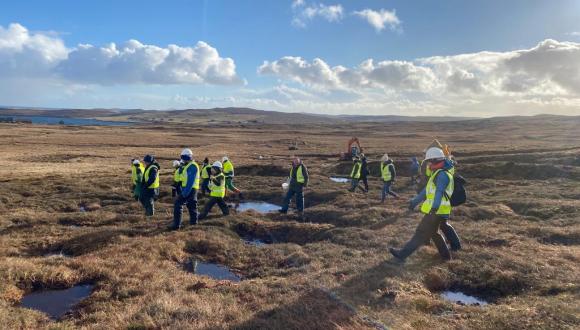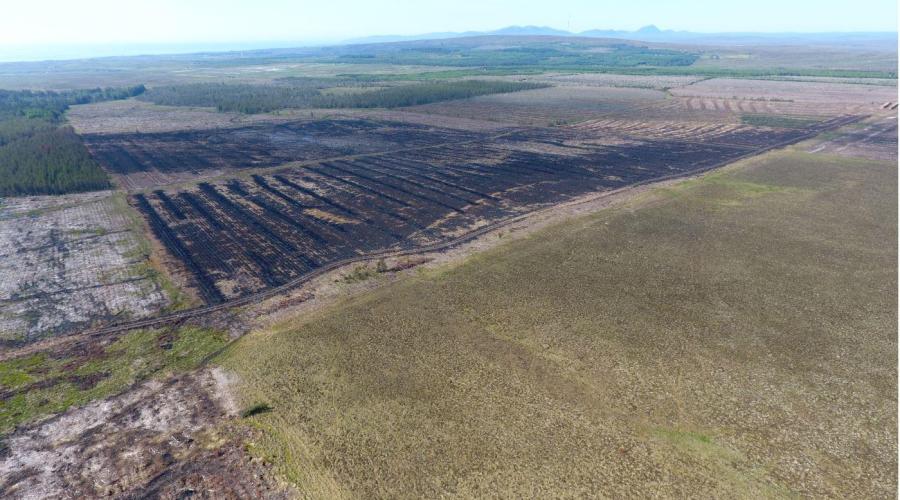
Peatland ACTION case study: What’s the connection between peat and wildfire?
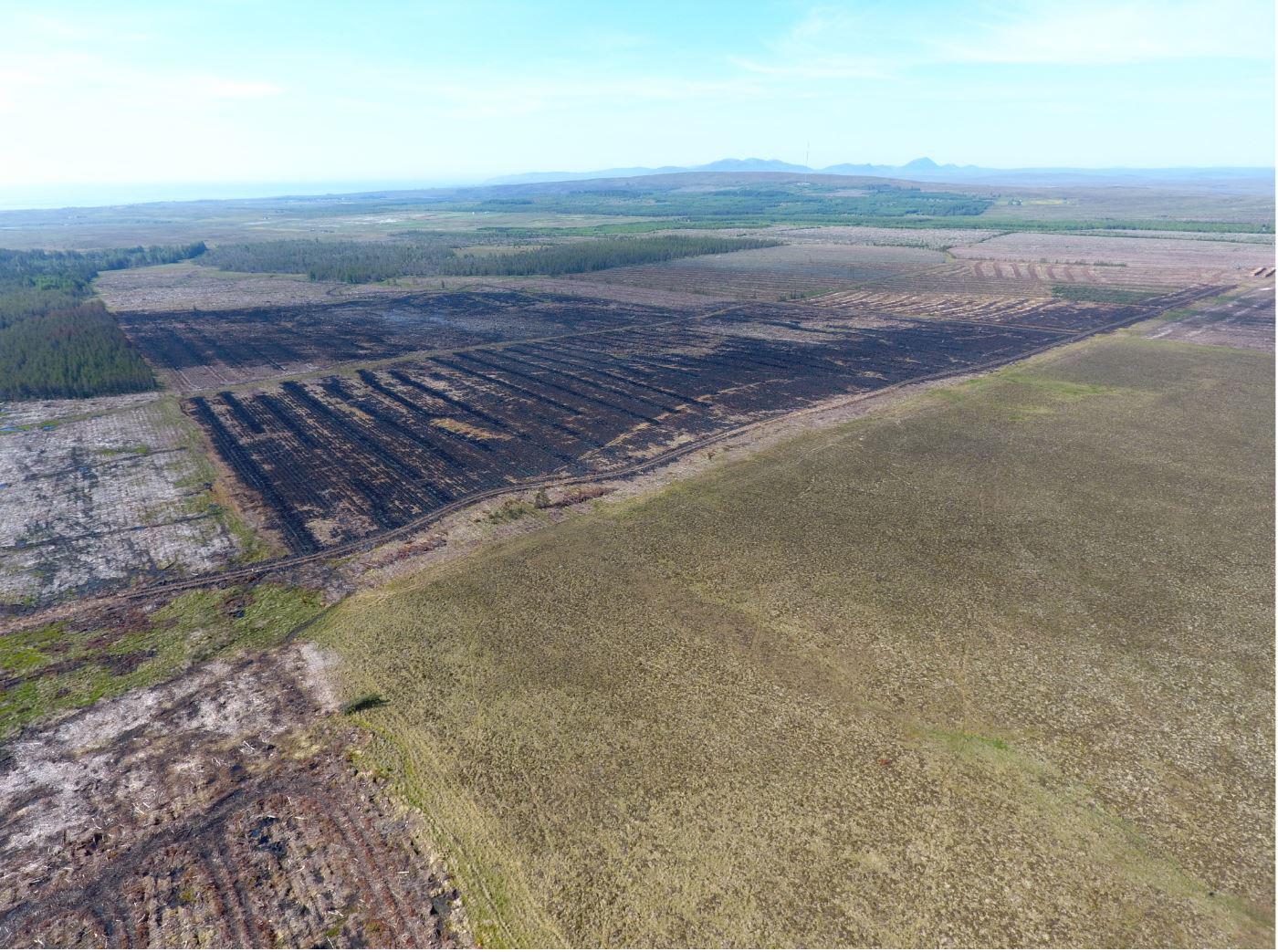
Peatland ACTION case study: What’s the connection between peat and wildfire?
The answer lies in helping to reduce the risk and spread of wildfires.
Golticlay
Golticlay is the eastern half of Rumster Forest in Caithness. It is bordered to the north and east by Shielton Peatlands Site of Special Scientific Interest (SSSI) and the Munsary Plantlife Reserve, which in turn, form part of the Caithness and Sutherland Peatlands Natura Network.
The peatland restoration work here will add an important piece to this jigsaw of sites that help protect and improve the area’s biodiversity.
However another benefit of this kind of peatland restoration came into sharp focus in 2018, when a fire which started at a nearby active timber harvesting site swept across other parts of the forest. The combination of the wetter surface thanks to the higher water table, an increase in peatland vegetation and the removal of scrub on the areas where peatland restoration work had taken place stopped the fire in its tracks - with the stark line between scorched black and lush green clear to see from the air.
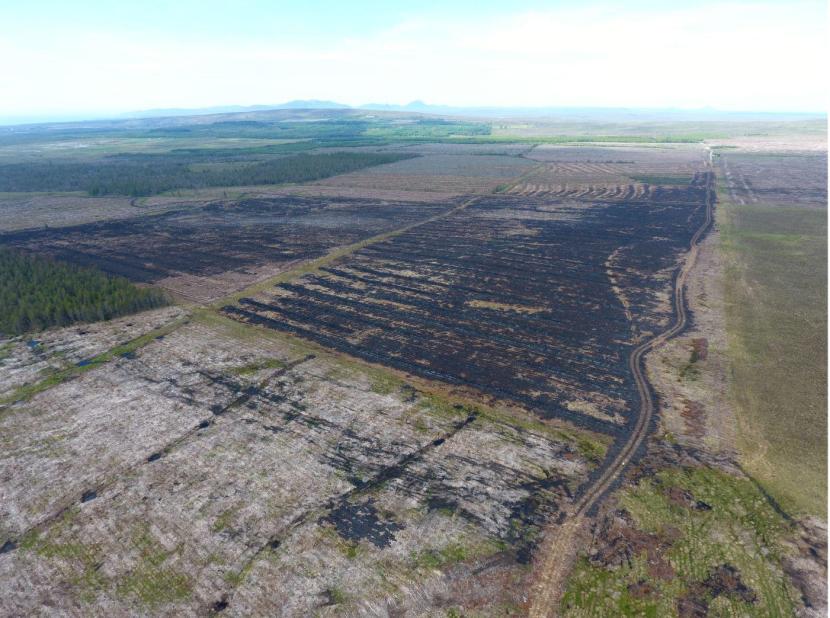
This peatland restoration project was supported by Forestry and Land Scotland / Peatland ACTION
©Forestry and Land Scotland / Peatland ACTION
Peatland restoration at Golticlay
In 2017-18 39ha of un-harvestable conifers were felled to recycle at Golticlay, using an excavator-based mulcher. The area was subsequently rewetted using an excavator to block the furrow network and dam the forest drains. Regenerating non-native conifers were removed from a further 27ha of existing open bog, and 75ha of previously clearfelled plantation were rewetted using ground smoothing techniques. By removing potential seed sources and hydrological interference these measures have helped considerably in protecting the Shielton peatland SSSI.
In 2018-19 the work started the previous year was completed by ground smoothing the remaining 33ha of clearfelled plantation in the north eastern corner of the block.
The former crop had been planted during the early 1980s using the standard techniques of the day (deep ploughing and draining), which in turn had left a legacy of intensive plough furrows and drainage channels. The crop had been harvested during the spring/summer of 2018 using a lightweight harvester with an extended reach and a medium-sized forwarder equipped with eco tracks. Significant effort went into planning and working the site with the result that timber recovery had been maximised and ground damage minimised.
The ground smoothing was delivered using a standard excavator fitted with low ground pressure tracks and a 1.0m toothed bucket. The work was carried out between January and March 2019. Good results were achieved across the whole site with evidence already pointing to the fact that the rewetting has been a success.
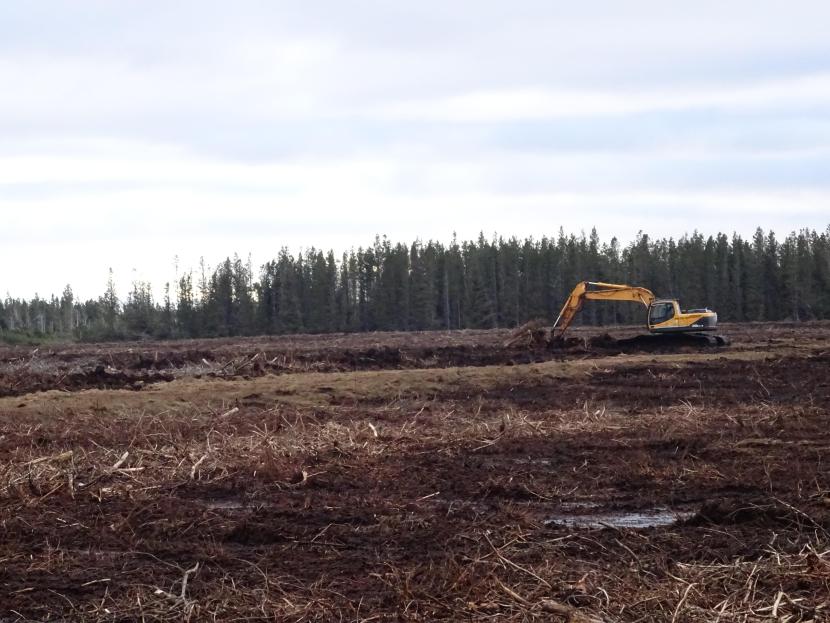
The furrows are flattened, and tree stumps flipped and buried - with the aim of raising the water table and creating conditions where peat forming sphagnum mosses and other key bog plants recolonise the bog.
This peatland restoration project was supported by Forestry and Land Scotland / Peatland ACTION
©Forestry and Land Scotland / Peatland ACTION
Some non-native conifer regeneration was present on the old forest ride network. This was removed as part of the project using standard motor manual techniques (cutting with chainsaws, loppers or hand pulled). Any regeneration on the previously clearfelled sites was buried as part of the ground smoothing operation.
While not directly a part of the restoration project, the deer fence that previously surrounded the plantation was also taken down and realigned. As a result there is no longer a fence between the restored areas at Golticlay and the designated sites that surround this area.
Golticlay peatland restoration - Challenges
Most of the forests managed by Forestry & Land Scotland in Caithness were created in second half of the 20th century. In line with the practices of the day, many were established on peatland sites which were drained, ploughed, fertilised and subsequently planted with non-native conifers. These practices are no longer viewed as sustainable, with the ecological and climate change benefits of active bogs now being widely recognised. Forestry & Land Scotland wanted to identify suitable sites for inclusion in an ambitious and challenging programme of "forest to bog" restoration work.
In the past the main barriers to the delivery of this type of work were the lack of available funding and the absence of a suitably skilled, well equipped contractor base. The underpinning of Forestry & Land Scotland’s peatland restoration programme by Peatland ACTION enabled local contractors to invest in specialist equipment and to “up-skill” their workforce. This in turn, led to the development and application of more cost effective techniques for bog restoration. This meant that the project helped support the rural economy within the area as all works were delivered using these local contractors.
In doing the work at Golticlay the threat of non-native conifers colonising significant areas of priority open habitat within the forest has been removed. Over time, the rewetting of 33ha of former plantation will also increase the site’s carbon storage capacity, water regulation and biodiversity.
Last, but by no means least, the peatland restoration at Golticlay demonstrated in the most graphic way possible the ability of healthy peatlands to avert wildfires.
Golticlay peatland restoration - Benefits
Peatlands in good condition are one of the most robust open habitats found in Scotland’s landscape, along with other wetlands.
However peatlands that have been damaged, for example where drainage has been installed, are more likely to suffer more severe fire damage and spread fires to neighbouring areas. Drained or modified peatlands usually support the growth of heath type or grassy vegetation, increasing the amount of fuel available and drying out the layer of peat nearest the surface.
Restoring damaged peatlands raises the water table and encourages the growth of sphagnum mosses, which help reduce the severity and spread of fires within a given area. The re-wetting also suppresses the growth of grasses and heath-like vegetation, reducing the fuel load.
This evidence is more than anecdotal. The Fire Blanket project*, a research programme led by a team from the University of Highlands and Islands from 2019-21, compared the fire resilience of blanket bogs under different management regimes using measures of vegetation, moisture, peat properties, satellite-derived “bog breathing” and water quality.
They used a major wildfire that happened at Strathy, in the Flow Country, in 2018 as the study site. The project concluded that ‘restoration is likely to increase wildfire resilience and reduce wildfire severity. When taking management decisions at the landscape scale, strategic re-wetting around vulnerable areas (eg highly degraded, or undergoing forest-to-bog management leading to large volumes of brash on the ground), and techniques involving removal of brash/heather in addition to rewetting may help reduce the risks of occurrence of large catastrophic wildfires. This in turn should help minimise the carbon losses and biodiversity impacts associated with these events.’
References
* The Fire Blanket project: Andersen, R., Felgate, S., Fernandez-Garcia, P., Gaffney, P., Gilbert, P., Hancock, M., Large, D., Leith, F., Marshall, C., Mayor, D., McIlveny, J., Monteith, D., Pickard, A., Sanders, R., Williamson, B., (2021) Building wildfire fire resilience in the Flow Country peatlands. Environmental Research Institute, University of the Highlands and Islands, Thurso, UK. 17 pp.
Animations
Watch: Burning on blanket bogs Part 1 - Effects of fire animation based on evidence from experimental plots.
Watch: Burning on blanket bogs Part 2 - Recovery pathways animation demonstrating the differing pathways of recovery that may be observed, following cessation of burning on damaged blanket mire habitat.
For further information, or to get involved with Peatland ACTION
- We offer funding for suitable peatland restoration projects across Scotland
- We offer, where appropriate, multi-year funding
- We fund up to 100% of the capital costs
- We fund much of the pre-application work, for example, peat depth surveys and feasibility studies
- We have officers who can help design your project, offer advice on restoration management and assist you to complete your application and supporting information.
Peatland ACTION case studies: We demonstrate links between peat condition and: fisheries; grouse; carbon storage; wildlife; landscapes; human history; and so much more.
If you would like to contribute to the on-going work of Peatland ACTION please contact peatlandaction@nature.scot.
For further information: www.nature.scot/peatlandaction
